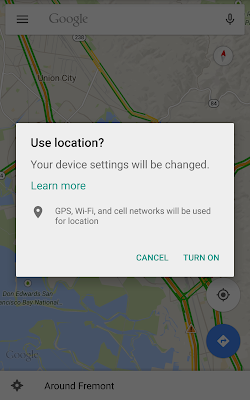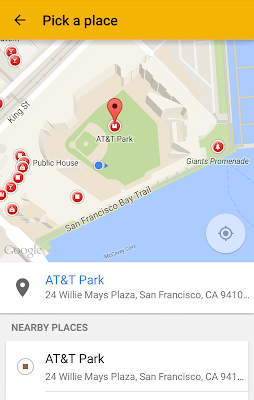Google Play services 7.0 – Places Everyone!
March 2nd, 2015 | Published in Google Android
Posted by Ian Lake, Developer Advocate
Today, we’re bringing you new tools to build better apps with the rollout of Google Play services 7.0. With this release, we’re delivering improvements to location settings experiences, a brand new API for place information, new fitness data, Google Play Games, and more.
Location Settings Dialog
While the FusedLocationProviderApi combines multiple sensors to give you the optimal location, the accuracy of the location your app receives still depends greatly on what settings are enabled on the device (e.g. GPS, wifi, airplane mode, etc). In Google Play services 7.0, we’re introducing a standard mechanism to check that the necessary location settings are enabled for a given LocationRequest to succeed. If there are possible improvements, you can display a one touch control for the user to change their settings without leaving your app.

This API provides a great opportunity to make for a much better user experience, particularly if location information is critical to the user experience of your app such as was the case with Google Maps when they integrated the Location Settings dialog and saw a dramatic increase in the number of users in a good location state.
Places API
Location can be so much more than a latitude and longitude: the new Places API makes it easy to get details from Google’s database of places and businesses. The built-in place picker makes it easy for the user to pick their current place and provides all the relevant place details including name, address, phone number, website, and more.

If you prefer to provide your own UI, the getCurrentPlace() API returns places directly around the user’s current location. Autocomplete predictions are also provided to allow a low latency search experience directly within your app.
You can also manually add places with the addPlace() API and report that the user is at a particular place, ensuring that even the most explorative users can input and share their favorite new places.
The Places API will also be available cross-platform: in a few days, you’ll be able to apply for the Places API for iOS beta program to ensure a great and consistent user experience across mobile platforms.
Google Fit
Google Fit makes building fitness apps easier with fitness specific APIs on retrieving sensor data like current location and speed, collecting and storing activity data in Google Fit’s open platform, and automatically aggregating that data into a single view of the user’s fitness data.
In Google Play services 7.0, the previous Fitness.API that you passed into your GoogleApiClient has now been replaced with a number of APIs, matching the high level set of Google Fit Android APIs:
-
SENSORS_APIto access raw sensor data via SensorsApi -
RECORDING_APIto record data via RecordingApi -
HISTORY_APIfor inserting, deleting, or reading data via HistoryApi -
SESSIONS_APIfor managing sessions via SessionsApi -
BLE_APIto interact with Bluetooth Low Energy devices via BleApi -
CONFIG_APIto access custom data types and settings for Google Fit via ConfigApi
This change significantly reduces the memory requirement for Google Fit enabled apps running in the background. Like always, apps built on previous versions of Google Play services will continue to work, but we strongly suggest you rebuild your Google Fit enabled apps to take advantage of this change.
Having all the data can be an empowering part of making meaningful changes and Google Fit is augmenting their existing data types with the addition of body fat percentage and sleep data.
Google Play Games
Announced at Game Developers Conference (GDC), we’re offering new tools to supercharge your games on Google Play. Included in Google Play services 7.0 is the Nearby Connections API, allowing games to seamlessly connect smartphones and tablets as second-screen controls to the game running on your TV.
App Indexing
App Indexing lets Google index apps just like websites, enabling Google search results to deep-link directly into your native app. We've simplified the App Indexing API to make this integration even easier for you by combining the existing view()/viewEnd() and action()/end() flows into a single start() and end() API.
Changes to GoogleApiClient
GoogleApiClient serves as the common entry point for accessing Google APIs. For this release, we’ve made retrieval of Google OAuth 2.0 tokens part of GoogleApiClient, making it much easier to request server auth codes to access Google APIs.
SDK Coming Soon!
We will be rolling out Google Play services 7.0 over the next few days. Expect an update to this blog post, published documentation, and the availability of the SDK once the rollout is completed.
To learn more about Google Play services and the APIs available to you through it, visit the Google Services section on the Android Developer site.
+Android Developers